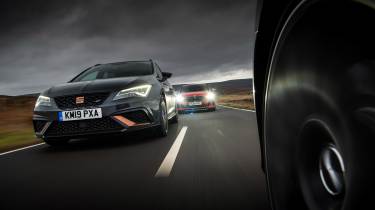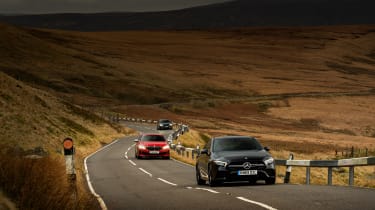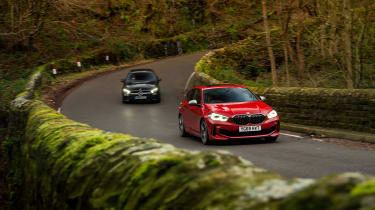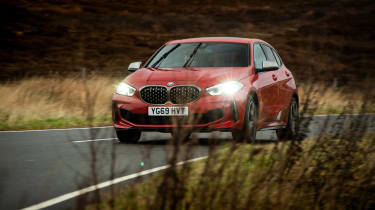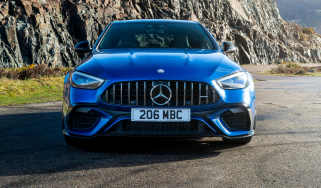Mercedes-AMG A35 saloon vs BMW M135i vs SEAT Leon Cupra R ST Abt
Three all-wheel drive, turbocharged four-cylinder performance machines, three different body styles
One of the great pleasures of owning a Subaru Impreza or Mitsubishi Evo must be opening the curtains on a winter’s morning to a blanket of pristine white snow. While poor weather would be the excuse for most drivers to crawl back between the sheets and add another 30 minutes to their alarms, a select few cars revel in uncertain conditions. They tread confidently where the rest hesitate, and impart reassurance to their drivers where others send mixed messages.
We have three such cars with us today. The skies over the Peak District are heavy with misery, gusts of wind cut through to the bone, and ‘road liable to flooding’ signs litter the verges like oversized confetti. It’s not snowing, and it isn’t raining either (yet…), but we’re promised a dousing after lunch, and in the meantime the greasy, winter-ravaged asphalt still makes our trio preferable to most front- or rear-drivers you’d care to mention.
Two hail from evo’s very prior long-term fleet, in the shape of art editor Rich Browne’s old metallic Melbourne Red BMW M135i xDrive, and dep ed Adam Towler’s SEAT Leon Cupra R ST Abt in a shade called Blackness Grey. The latter is set off both by copper-coloured details (‘ginger’, according to editor Stuart Gallagher) and subtle Abt badges.
The Abt tweaks, detailed in Fast Fleet in evo 268, lift power to a not-insignificant 345bhp from the standard 296bhp, which makes the Cupra the most powerful car here by some margin. The BMW, which also has a 2-litre four-cylinder engine, musters 302bhp, while the third car of our gathering, a metallic Cosmos Black Mercedes-AMG A35, again with a 2-litre four, makes an identical 302bhp.
As we’ll discover, the way these cars deliver their outputs is far from identical, despite all sending their power to all four wheels through paddleshift transmissions. Our trio also demonstrates the diversity of body styles in this segment – the BMW a traditional five-door hatchback, the Leon a five-door estate, and the Mercedes a four-door saloon, albeit a bijou one. While we’re not expecting the shapes to have much influence on the way they drive, it’s at least a positive sign that crossovers haven’t brought an end to such variety.
Styling does play a part for many though, so it’ll be interesting to see how diehard BMW fans take to the £36,430 M135i. It’s… not great, is it? Previous 1-series weren’t exactly pretty but at least had traditional front-engined, rear-drive proportions going for them, before you even got to rear-drive layouts or six-cylinder engines. But this latest car might just be the least cohesive shape BMW has penned this side of a 5-series GT.
The £37,975 Leon is vastly more appealing. Ginger detailing or not, its shape has aged exceptionally well, particularly in estate form, and the VW Group’s fancy metal panel stamps, capable of ultra-sharp edges, have rarely been put to better use than for the creases in the Leon ST’s flanks. It’s particularly fetching from the rear three-quarters, and despite its extra length over the other two here it carries far less visual bulk. There are, of course, practical benefits to the Leon too, and with BMW’s wagon alternatives being the X1 and X2 crossovers, and Mercedes’ upcoming CLA Shooting Brake more of a style-led device, the SEAT should remain the car for those who actually wish to transport large or inconveniently shaped objects.
It’ll take something special to overcome the £38,615 A35’s showroom pizazz, though. Next to the BMW it’s almost a Renaissance masterpiece, despite being probably the least appealing ‘35’ body style. Compared to the sleeker CLA35 it’s a little too tall and truncated, a little too close to those dubiously styled supermini-based saloons made for places such as China or India. But this example’s black-on-black colour scheme gives it an air of class the other two lack, and I soon warm to its ‘Hot Wheels E63 S’ vibe.
Whichever shape you choose you’re still privy to one of the best cabins in the class, with a pared-back dashboard, highly configurable screens, and when it’s dark an ambient cabin glow that’s simply more inviting than the token nocturnal illumination of the other two.
The Cupra offers a couple of configurable display options, of which the standard, round-dial look is most effective, while the Merc’s options seem almost endless. The Sport view is probably best, with a pair of clear, analogue-style gauges, though Supersport might appeal if you want to feel like Luke Skywalker threading down a trench on the Death Star.
It’s the BMW that lags, with difficult-to-read contra-rotating bar graphs pushed out to either side of the cluster. The rest of the cabin is a better effort, if rather generic – there’s been an effort to cant the centre console towards the driver, as in BMWs of old, but as I type this I’ve had to bring up an image of the dashboard just to recall what it looks like. Given the exterior styling I suppose ‘unmemorable’ is the lesser of possible crimes, and to BMW’s credit the 1 feels the most tightly constructed here.
The AMG’s fancy shapes are let down by the occasional rattle and a curiously nasty take on Merc’s traditional column-mounted transmission selector, and the Cupra now feels a bit flimsy, despite a welcome splash of Alcantara here and there. All three get their basic driving positions right, letting you draw the steering wheel into your chest and allowing you to sit a few notches off the floor if that’s your thing, but the best visibility belongs to the slim-pillared SEAT with its minimal blind spots.
It’s the bulkier Beemer I’ve driven up north in, impressed by its comfort, integrity and refinement, but mildly irritated by some of its other characteristics. The first is an automatic transmission that feels curiously unintuitive, shuffling up gears as quickly as they all do these days, but more reluctant to swap to a lower cog when you squeeze the left-hand pedal, making it feel lazy and disinterested.
Worse, there seems to be a complete absence of engine braking. I’m sure the ability to sail along for miles off-throttle is wonderful for fuel consumption, but if BMW is going to stick an M badge on the back of the car it’s reasonable to expect a more natural and connected feel when you roll on and off the throttle. It’s not just a symptom of a mushy Comfort mode either, as the situation’s only marginally better in Sport or when changing gears yourself with the apologetic steering wheel-mounted paddles. As an illustration of just how little resistance you get, the 135i struggled to hold a consistent 20mph on a fairly gentle downhill gradient in first gear for our tracking photography. Expect to spend a lot on brake pads as an M135i owner.
Then there are those dials. BMW instrument clusters used to be a model of clarity, but not here, and while a head-up display mitigates this to some extent, it doesn’t include a gear indicator to replace the minuscule number hidden away on the dial pack’s lower edge. And amusing though it is to see a ‘dangerous turn’ warning appear in the display every time the road veers away from the straight-ahead, this too seems somewhat at odds for a performance-orientated car that an owner might like to, for instance, enjoy driving around corners in.
And in fact the BMW is not bad at the whole cornering thing. The last few miles of last night’s drive were fun, and this morning’s first run is proving entertaining too. Held in Sport mode and choosing gears yourself, the transmission is just about liveable, throttle response is good, and with a stiff structure and sensible damping the BMW dances over the broken surface without a shudder. With quick, Mini-like steering (the 1-series shares its platform with the Clubman) it doesn’t take much effort to pitch the nose into a turn, and like the current Minis the 135i responds well to a slightly more gung-ho style of driving, making best use of the sharp turn-in and a throttle lift to get the rear axle involved. It’s not snappy, but it’s always up for a quick sequence of corners, and the car immediately settles as you feed in more throttle. The pliant ride is paired with good body control too, so it feels unfazed by dips and crests and quick changes of trajectory.
This, though, seems to be where the 1-series’ dynamic character begins and ends. While the steering is quick and less gloopy than some recent BMW racks, there’s also not much in the way of feedback. And while undoubtedly agile, the car feels more like a competent front-driver than a dynamic all-wheel-drive car, and even further from its rear-drive predecessor. The engine seems mostly disinterested too – there’s little to be gained from revving beyond its healthy mid-range, and while it’s a smooth unit, neck hairs will go unprickled by BMW’s token effort at piped-in sound.
SEAT has had a better go with the Leon, which growls at you on start-up and then offers a variation on that growl everywhere else. It has that familiar Volkswagen Group voice of a four-cylinder trying desperately to sound like it has one or two more, but the EA888 feels a bit old-school these days, with a gravelly tone and slightly busy feel at all speeds that make the others seem like models of refinement. That extends to the Cupra’s structure, which is very obviously a generation behind the others now (indeed its replacement has just been revealed). Perhaps it’s a factor of the longer estate body, but over certain stretches of road the SEAT creaks and fidgets, despite a ride quality – even in Cupra mode – that isn’t far behind offering the BMW’s level of pliancy.
The more you drive the Cupra, the more its talents become apparent. Turn-in isn’t as quick as in the others and there’s not the same level of weight to the steering, but response and feedback seem to meet you halfway as you build up the pace. Despite its extra length the SEAT is actually the most expressive car here, keenest to rotate into a turn, and feels the most rear-driven once you get back on the power, more alive at every stage of the process.
Sometimes things do get a bit scrappy, perhaps a symptom of the older platform, the weight hanging out behind you and the slight imprecision to initial steering inputs. On slippery surfaces it’s not unusual for the Cupra’s front end to push on turn-in, morphing quickly to oversteer as you lift the throttle to control it, and yanking straight again as you get back on the power. The SEAT is also the only one of the three to lean noticeably on its stability control through one particular corner, as the front wheels go through their slip-then-grip sequence at a rather higher speed.
And high speed is something the Leon does very easily indeed. With a sixth more power than the others it’s no great shock that the Abt-fettled SEAT is quicker in a straight line, but that doesn’t stop it plastering an enormous grin across your face the first time you sink your foot to the carpet and the entire Peak District turns to a greeny-grey blur.
What the Leon’s lump lacks in low-end response, needing a little more stoking than the BMW or AMG units from low revs, it more than makes up for as the needle passes 3000rpm or so. In a world of flat torque curves the SEAT’s seemingly exponential rate of acceleration is quite addictive, and with the old DSG ’box still lightning fast under full throttle, the thrust never really lets up. The way the Cupra lassoes between corners feels anything but routine, even in a class where 300-plus horsepower has become the norm.
It’s enough to take the wind out of the AMG’s sails, at any rate. In isolation the A35 feels punchy, but the SEAT’s lunacy relegates it to second place in the straight-line stakes, in turn ahead of the laid-back BMW. But there’s plenty to like about the AMG’s engine even so. It’s the most eager to respond to small throttle inputs, its dual-clutch ’box changing down intuitively when you ask for a bit more go, while also not being too eager to change up again through gnarlier sequences. It’s better still in manual mode, the selection of which also prevents it changing up of its own accord when you stray close to the red line, something it’ll do in auto even in the farts ‘n’ pops Sport+ mode. The Merc’s cabin theatre also extends to its proper metal gearshift paddles, the clickety action of which is nearly as engaging as using a proper manual ’box, and the changes they command, while not as snappy or smooth as the SEAT’s, are more responsive than the BMW’s.
Like the SEAT, the A35’s powertrain is rare for a turbo four in that it’s even more keen at the top end than it is everywhere else. It’s a motor that incentivises you into making the most of each gear rather than surfing the mid-range, and aurally it falls between the slightly raucous SEAT and subdued BMW, mixing aggression with free-spinning response.
In fact, the Mercedes treads the middle ground between its German and Spanish rivals virtually everywhere. Its steering falls midway in terms of weight and response, lighter than the BMW’s but more accurate and garrulous than the Cupra’s, and its chassis splits the pair too – it has the keen front end and mid-corner security of the BMW, yet feels neutral like the SEAT when you get back on the power.
Unlike the Cupra (or the A35’s brawnier and more engaging A45 S sibling) you rarely feel the power making its way fore and aft based on the car’s cornering attitude, but you can exploit the benefits at corner exit, simply planting your foot and feeling the AMG match your steering input precisely. No trace of understeer or sense of your line getting tighter, just efficient drive and considerable speed.
The one area where the Mercedes lags behind both of the others is in ride quality. We’ve observed in the past that the AMG A-classes actually ride better than their non-AMG counterparts, but the A35 can occasionally feel brittle where the BMW smothers and the SEAT feels fleet-footed. It’s far from punishing, but it takes the edge off the Merc’s integrity on rougher roads.
Just as when the A35 hatch faced the Golf R a few months back (evo 261), you could misinterpret the Merc’s more tied-down nature as a lack of character, and like the VW in that test, the SEAT does feel lighter on its feet than the AMG. But importantly, the A35’s competence doesn’t come at the expense of engagement. Its combination of well-judged steering, keen throttle responses, an engaging power delivery and strong and progressive brakes (a quality shared among all three, incidentally) add up to a car that’s fun when you want it to be and utterly secure when the heavens open, while the fantastic cabin makes it a joy to live with.
The SEAT’s balance is further towards pure entertainment, but the platform and everything attached to it is no longer at the cutting edge of this class. Then again, it’s also seven years old. Its slightly raw nature and rocketship pace can be very entertaining, and it’s undoubtedly the best-looking of the three here, so perhaps it gets the moral victory – a reminder to car manufacturers that there’s room for something more boisterous even when practicality or all-weather security are priorities.
It’s a message BMW would do well to heed. The M135i xDrive feels like a car with no real USP. It’s sure to sell well to those for whom easy straight-line performance and a BMW badge are all that matter, but where the old M140i could always be suggested as an alternative for those who wanted rear-wheel drive or a sonorous straight-six, the latest car is a facsimile of its rivals – yet every one of those rivals does the same job better. We suspect there’s a good evo car within the new 1-series, it just needs BMW to discover it.
So it’s the A35 Saloon that wins, a small margin ahead of the fun but less well-rounded SEAT, with the BMW trailing a distant third. All, though, demonstrate one thing: there’s no such thing as bad weather – just the wrong kind of car.

